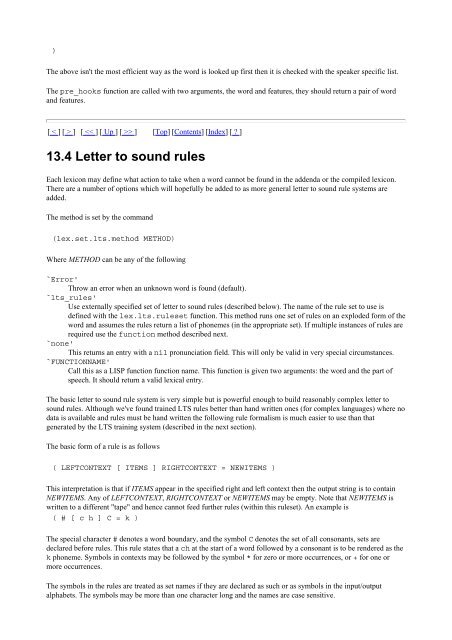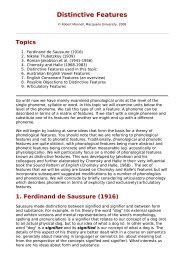Festival Speech Synthesis System: - Speech Resource Pages
Festival Speech Synthesis System: - Speech Resource Pages
Festival Speech Synthesis System: - Speech Resource Pages
Create successful ePaper yourself
Turn your PDF publications into a flip-book with our unique Google optimized e-Paper software.
)<br />
The above isn't the most efficient way as the word is looked up first then it is checked with the speaker specific list.<br />
The pre_hooks function are called with two arguments, the word and features, they should return a pair of word<br />
and features.<br />
[ < ] [ > ] [ > ] [Top] [Contents] [Index] [ ? ]<br />
13.4 Letter to sound rules<br />
Each lexicon may define what action to take when a word cannot be found in the addenda or the compiled lexicon.<br />
There are a number of options which will hopefully be added to as more general letter to sound rule systems are<br />
added.<br />
The method is set by the command<br />
(lex.set.lts.method METHOD)<br />
Where METHOD can be any of the following<br />
`Error'<br />
Throw an error when an unknown word is found (default).<br />
`lts_rules'<br />
Use externally specified set of letter to sound rules (described below). The name of the rule set to use is<br />
defined with the lex.lts.ruleset function. This method runs one set of rules on an exploded form of the<br />
word and assumes the rules return a list of phonemes (in the appropriate set). If multiple instances of rules are<br />
required use the function method described next.<br />
`none'<br />
This returns an entry with a nil pronunciation field. This will only be valid in very special circumstances.<br />
`FUNCTIONNAME'<br />
Call this as a LISP function function name. This function is given two arguments: the word and the part of<br />
speech. It should return a valid lexical entry.<br />
The basic letter to sound rule system is very simple but is powerful enough to build reasonably complex letter to<br />
sound rules. Although we've found trained LTS rules better than hand written ones (for complex languages) where no<br />
data is available and rules must be hand written the following rule formalism is much easier to use than that<br />
generated by the LTS training system (described in the next section).<br />
The basic form of a rule is as follows<br />
( LEFTCONTEXT [ ITEMS ] RIGHTCONTEXT = NEWITEMS )<br />
This interpretation is that if ITEMS appear in the specified right and left context then the output string is to contain<br />
NEWITEMS. Any of LEFTCONTEXT, RIGHTCONTEXT or NEWITEMS may be empty. Note that NEWITEMS is<br />
written to a different "tape" and hence cannot feed further rules (within this ruleset). An example is<br />
( # [ c h ] C = k )<br />
The special character # denotes a word boundary, and the symbol C denotes the set of all consonants, sets are<br />
declared before rules. This rule states that a ch at the start of a word followed by a consonant is to be rendered as the<br />
k phoneme. Symbols in contexts may be followed by the symbol * for zero or more occurrences, or + for one or<br />
more occurrences.<br />
The symbols in the rules are treated as set names if they are declared as such or as symbols in the input/output<br />
alphabets. The symbols may be more than one character long and the names are case sensitive.
















